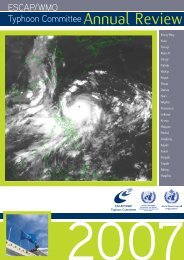TCAR - Typhoon Committee
TCAR - Typhoon Committee
TCAR - Typhoon Committee
Create successful ePaper yourself
Turn your PDF publications into a flip-book with our unique Google optimized e-Paper software.
56<br />
ESCAP/WMO<br />
<strong>Typhoon</strong> <strong>Committee</strong> Annual Review 2009<br />
clarifying the point at which evacuation is required.<br />
The synergetic effects of these efforts are expected<br />
to lead to voluntary and rapid evacuation when<br />
necessary.<br />
The year 2009 marks the final part of a three-year<br />
extension of these efforts. The WS, which was held in<br />
Cebu in the Philippines as a pre-meeting on September<br />
13 and as a WHG workshop from September 14 to 18,<br />
confirmed the related activities undertaken over the<br />
past eight years and also discussed the draft final<br />
report for the whole project. First, Japan, which has<br />
provided leadership in the FHM project, outlined the<br />
activities of member countries and highlighted the<br />
key achievements of the project. In response, China,<br />
the Philippines, Vietnam and other members made<br />
comments to reflect latest efforts of each country.<br />
After the workshop, each country confirmed the<br />
content of the final report, and participating members<br />
presented knowledge and obtained know-how from<br />
each other. The achievements of the FHM project<br />
include actual recommendations for water-related<br />
disaster prevention.<br />
The lessons learned from the project were<br />
summarized as follows in the final report:<br />
I. Effectiveness of FHM<br />
1) FHM is an essential countermeasure to reduce<br />
flood damage at national/local/individual level.<br />
2) FHM can be effective within shorter-period of time,<br />
while structural measures such as embankment or<br />
dams need a longtime to be constructed.<br />
3) The most suitable FHM for a certain area can be<br />
built-up, combining topographic<br />
map, past flood investigation, inundation analysis and<br />
required data.<br />
II. Role of the central government<br />
1) To reduce human/economic losses, FHM should<br />
acquire a primary position in national disaster<br />
prevention policy.<br />
2) Through the FHM project, a right perception on<br />
supposed disaster and facilities’ capacity shall be<br />
recognized in local society.<br />
3) For popularization of FHM, the central government<br />
is expected to set up a legal<br />
regulation, immediate target and technical domestic<br />
support system.<br />
III. Action in local community<br />
1) Local government/NGO shall connect flood fighting<br />
services and residents by FHM, and brush it up by<br />
referring to many activities in other regions.<br />
2) Residential collaborative action of information/<br />
experience sharing is a key factor of FHM to ensure<br />
the local livelihood sustainability.<br />
3) FHM work may become a culture to live in floodprone<br />
area through identification of<br />
area-specific dangers, resources and warning<br />
messages.<br />
(KRA1, 2, 6, 7)<br />
f. Identified Opportunities/Challenges for Future<br />
Achievements/Results<br />
6. Progress on Key Result Area 6: Improved<br />
Capacity to Generate and Provide Accurate, Timely<br />
and understandable Information on <strong>Typhoon</strong>related<br />
Threats.<br />
a. Meteorological Achievements/Results<br />
a-1. Improvement of Observation Systems<br />
Radar observation<br />
Five Conventional Radars Replaced with Doppler<br />
Radars by JMA JMA operates 20 weather radars<br />
that are designed to collectively cover the whole<br />
areas around Japan to observe the development of<br />
precipitation systems three dimensionally, and in 2006<br />
JMA began replacements of conventional radars with<br />
new Doppler radars. By April 2010, 5 conventional<br />
radars, those at Sapporo, Fukui, Osaka, Hiroshima<br />
and Ishigakijima, will be newly replaced with Doppler<br />
radars in addition to the existing 11 Doppler radars<br />
that are already operating. After April 2010, the<br />
network of those 16 Doppler radars will contribute to<br />
disaster prevention through the provision of detailed<br />
meteorological information about strong wind and<br />
through the incorporation of the data into Numerical<br />
Weather Prediction to give more accurate products.<br />
Interval of Weather Radar Observation Shortened<br />
In response to the extensive damage caused by a<br />
series of local heavy rains in many parts of Japan<br />
during the summer of 2008, JMA shortened the<br />
observing interval of weather radars from 10 to 5<br />
minutes in July 2009 with the aim of early detection<br />
of developing precipitation cells which may bring local<br />
heavy rainfall. This shortening was made possible after<br />
we reorganized the scan sequence of each of the 20<br />
countrywide weather radars, and as a result we can<br />
produce the nationwide radar-echo composite maps<br />
every 5 minutes. Those maps are used in real-time by

















